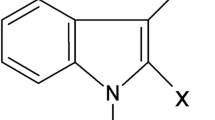Abstract
Studies were aimed to understand the role of orthosilicic acid (OSA) in improving seedling development. Different concentrations (0.1 % or 0. 2 % v/v) of Silixol (a proprietary formulation with stabilized orthosilicic acid 0.8 %) were used. Seeds were treated with Silixol in two ways: wet coating and overnight soaking. Seeds wet coated with Silixol exhibited good seedling vigour coupled with increased seedling length and biomass. Seeds soaked overnight in a liquid Silixol (diluted at 0.1 % or 0.2 %) solution exhibited a similar response in terms of seedling vigour and biomass. The application of Silixol is attributed to better seedling vigour along with 25 % increase in seedling length and 64 % increase in the fresh weight over control seeds.
A foliar spray of Silixol enhanced uptake of essential nutrient (viz. P, Ca and K), when applied in the nursery. Seedlings sprayed with Silixol had higher levels of chlorophyll content over the control, accounting for a higher rate of photosynthesis. A threefold increase in the seedling length was recorded in the sprayed plants compared to the unsprayed.
In main fields, foliar sprays at three critical stages of rice (active tillering 25 DAT, panicle initiation 40 DAT and heading 60 DAT), resulted in better seedling development. Various growth parameters viz., root volume, number of tillers along with various yield attributing traits were recorded better in sprayed plants compared to the control. An improvement in quality of grains was also recorded in terms of uniformity in size as well as shininess. Husks of grains harvested from sprayed plants had lower infestation by the pests and pathogens. Three foliar applications of Silixol culminated in an average yield increment of ∼15 %, irrespective of variety. In addition to this the incidence of white earheads was reduced in a sprayed plot (4.3/sq m) compared to a control plot (10.3/sq m).
Similar content being viewed by others
References
Adatia MH, Besford RT (1986) The effects of silicon on cucumber plants grown in recirculating nutrient solution. Ann Bot 58:343–351
Arnon DI (1949) Copper enzymes in isolated chloroplasts polyphenol oxidase in Beta vulgaris. Plant Physiol 24:1–15
Ayres AS (1966) Calcium silicate slag as a growth stimulator for sugarcane on low-silicon soils. Soil Sci 101:216–227
Costa Crusciol CA, Soratto RP, Castro GSA, Neto CHMJF (2013) Foliar application of stabilized silicic acid on soybean, common bean and peanut. Rev Ciênc Agron 44:404–410
Epstein E (1994) The anomaly of silicon in plant biology. In: Proceedings of the National Academy of Sciences of the United States of America, vol 91, pp 11–17
Epstein E (1999) Silicon. Ann Rev Plant Physiol Plant Mol Biol 50:641–664
Gascho GJ (2001). In: Datnoff LE, Snyder GH, Korndorfer GH (eds) Silicon sources for agriculture. Elsevier, Amsterdam, pp 197–207
Jones LHP, Handreck KA (1967) Silica in soils, plants, and animals. Adv Agron 19:104–149
Karremans G, Bent E, Laane HM (2005) Strategy for the use of a foliar spray with stabilized oligomeric silicic acid and boric acid (OSAB®;). Abstract submitted to Proceedings of 3rd Conference on Silicon in Agriculture at Brazil
Laane HM (2010) Effect of OSAB3 (foliar spray of Silicic Acid and Boric Acid) on Bangalore blue grapes. Presented at Indo-US Workshop on Silicon in Agriculture, at University of Agricultural Sciences. GKVK Campus, India
Laane HM (2011) Foliar silicic acid technology for plants. Abstract submitted in Proceedings of 5th International Conference on Silicon in Agriculture, Beijing
Lewin CJ, Reimann BE (1969) Silicon and plant growth. Annu Rev Plant Physiol 20:289–304
Liu HX, Shen HR, Guo ZG (2011) Effect of silicon on seed germination and seedling growth of alfalfa. Acta Prataculturae Sinica 1:023
Ma JF, Tamai R, Yamaji N, Mitani N, Konishi S (2006) A silicon transporter in rice. Nature 440:688–691
McCray JM, Mylavarapu R (2013) Sugarcane nutrient management using leaf analysis. SS-AGR-335, Florida Sugarcane Handbook. www.http.edisifas.ufl.edu
Prakash NB, Chandrashekar N, Mahendra C, Patil SU, Thippeshappa GN, Laane HM (2011) Effect of foliar spray of soluble silicic acid on growth and yield parameters of wetland rice in hilly and coastal zones soil of Karnataka, South India. J Plant Nutr 34:1883–1893
Realpe OHR, Laane HM (2008) Effect of the foliar application of soluble oligomeric silicic acid and low dose of boric acid on papaya trees. Abstract presented in Proceedings of 4th International Conference on Silicon in Agriculture, South Africa
deSilva VF, Moraes JC, Melo BA (2010) Influence of silicon on the development, production and infestation by insect pests in potato crop. Ciênc Agrotec Lavras 34:1465–1469
Savant NK, Snyder GH, Datnoff LE (1997) Silicon management and sustainable rice production. Adv Agron 58:151–199
Soratto RP, Fernandes AM, Costa Crusciol CA, de Souza-Schlick GD (2012) Yield, tuber quality and disease incidence on potato crop as affected by silicon leaf application. Pesq Agropec Bras Brasilia 47:1000–1006
Yamaguchi T, Tsuno Y, Nakano J, Mano P (1995) Relationship between root respiration and silica: Calcium ratio and ammonium concentration in bleeding sap from stem in rice plants during the ripening stage. Jpn J Crop Sci 64:529– 536
Yoshida S (1975) The physiology of silicon in rice. Technical bulletin, no. 25. Food and Fertilizer Technology Centre, Taiwan
Author information
Authors and Affiliations
Corresponding author
Rights and permissions
About this article
Cite this article
Neeru, J., Shaliesh, C., Vaishali, T. et al. Role of Orthosilicic Acid (OSA) Based Formulation in Improving Plant Growth and Development. Silicon 11, 2407–2411 (2019). https://doi.org/10.1007/s12633-015-9380-x
Received:
Accepted:
Published:
Issue Date:
DOI: https://doi.org/10.1007/s12633-015-9380-x




